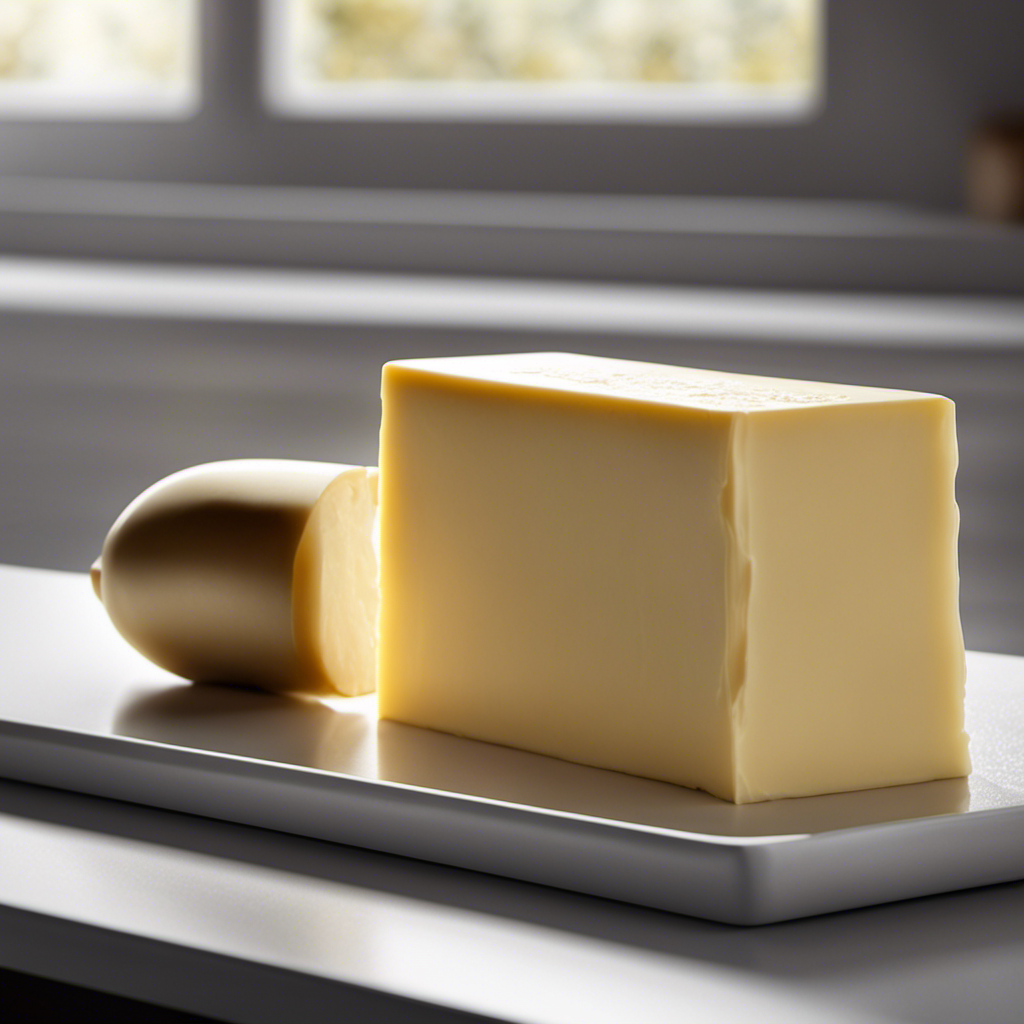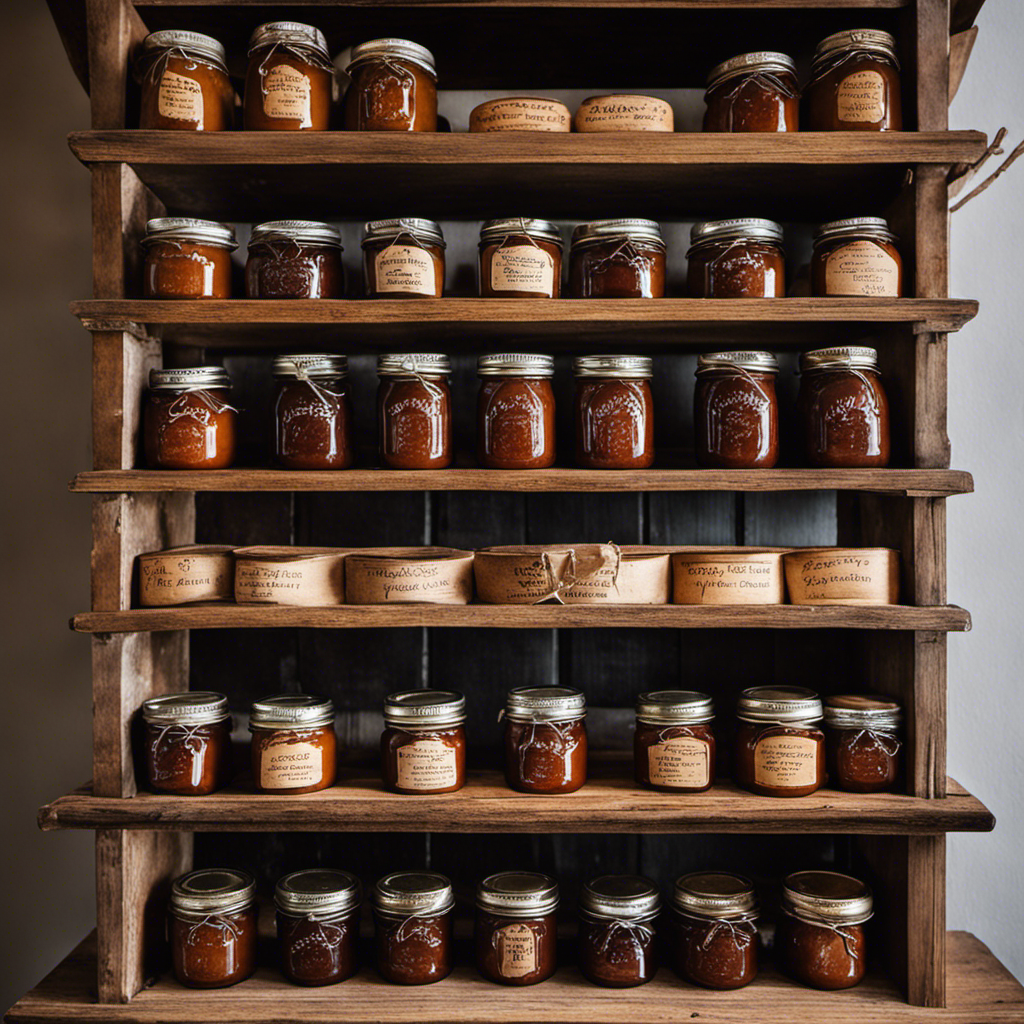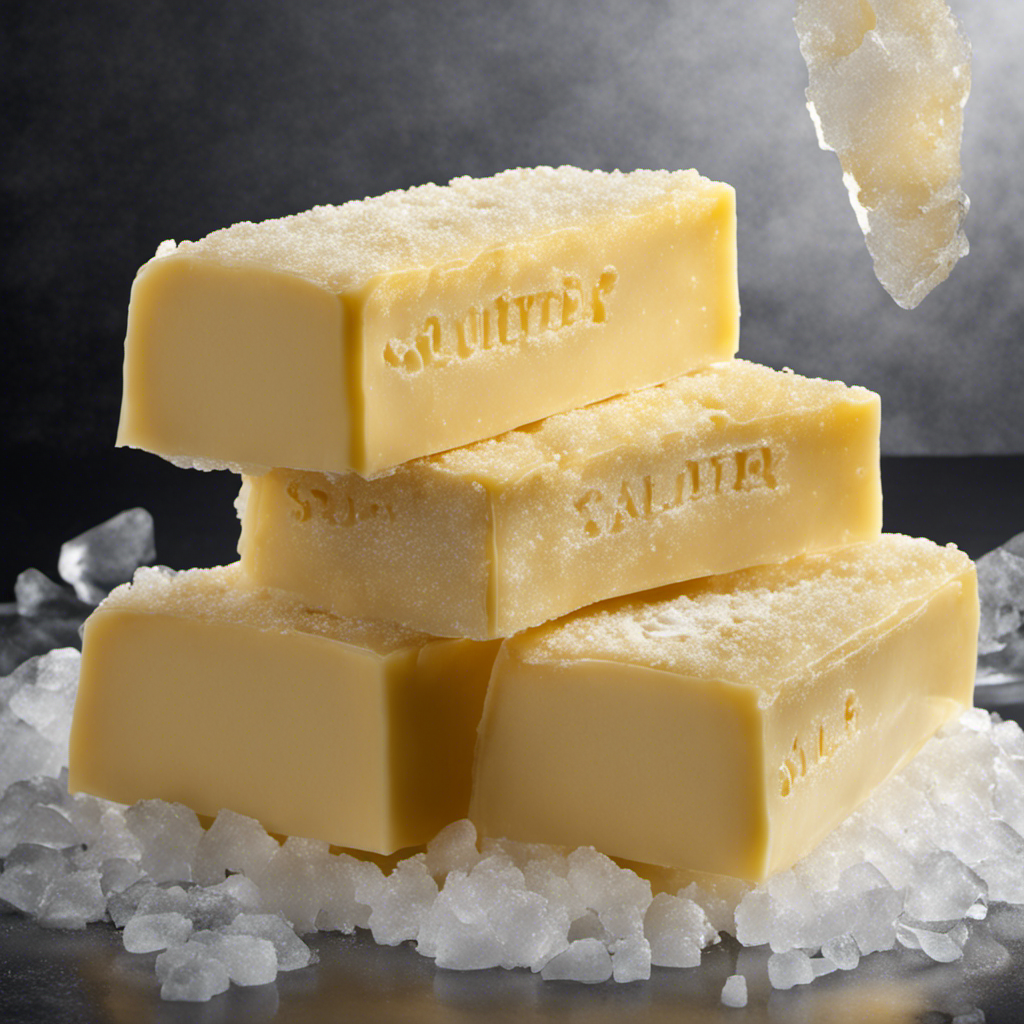Have you ever thought about how much time it takes for butter to reach room temperature? Well, I have the answer for you.
In this article, I’ll delve into the science behind the process and share some quick methods to soften butter in a jiffy.
From using the microwave to storing butter for easy softening, I’ve got you covered.
So, sit back and get ready to learn all about the importance of room temperature butter and how to make it happen in no time.
Key Takeaways
- Room temperature butter is crucial for achieving desired texture in baking recipes.
- Factors affecting softening time of butter include room temperature, humidity levels, wrapping, size of butter pieces, and proximity to a heat source.
- Microwaving butter can be a quick method, but caution is needed to avoid overheating.
- Alternatives to microwaving include the stovetop method and the warm water bath method.
The Importance of Room Temperature Butter
Room temperature butter is crucial for achieving the desired texture in baking recipes. The importance of softened butter cannot be overstated.
When butter is at room temperature, around 68 to 70 degrees Fahrenheit (20 to 21 degrees Celsius), it is much easier to cream with sugar, resulting in a light and fluffy mixture. This creaming process helps to incorporate air into the batter, creating a tender and moist final product.
If the butter is too cold, it won’t mix properly, leading to a denser and less evenly baked treat. On the other hand, if the butter is too warm, it can cause the dough to become greasy and spread excessively during baking.
Therefore, achieving the optimal butter temperature is essential for successful baking.
Factors Affecting the Time Required for Butter to Come to Room Temp
One factor that affects how quickly butter reaches the proper temperature is the ambient conditions in which it is stored. Factors affecting butter softening time include:
- Room temperature: Butter will soften faster in a warmer environment.
- Humidity: Higher humidity levels will also speed up the softening process.
- Packaging: Butter that is tightly wrapped will take longer to soften compared to butter that is exposed to the air.
To soften butter in warm environments, here are some tips:
- Cut the butter into smaller pieces to increase the surface area exposed to the warm air.
- Place the butter near a heat source, such as a warm oven or on top of a radiator.
- Use a microwave on low power for short intervals, checking frequently to avoid melting.
Using the Microwave to Soften Butter
When it comes to softening butter quickly, the microwave is a popular choice. However, it’s important to do so safely to avoid any accidents or overheating.
In this discussion, we will explore the proper way to microwave butter, as well as alternative methods for softening it, and what to expect in terms of butter consistency after microwaving.
Microwaving Butter Safely
To safely microwave butter, you can soften it by using short intervals and checking its consistency frequently. This method ensures that the butter doesn’t melt or become too soft, which can affect the texture of your baked goods.
Here are some tips to microwave butter safely and achieve the perfect consistency:
- Start with a microwave-safe bowl and cover the butter with a microwave-safe lid or paper towel to prevent splattering.
- Microwave the butter on low power or defrost setting to avoid overheating.
- Set the microwave for 10-second intervals and check the butter’s consistency after each interval.
- Gently press the butter with your finger to feel if it’s soft but still holds its shape.
Alternatives to Microwave
Using a stovetop method or a warm water bath are alternative ways to soften butter if you don’t have a microwave. When it comes to butter alternatives for achieving room temperature, these methods can be quite effective.
To soften butter on the stovetop, start by cutting the desired amount into small pieces and placing them in a heatproof bowl or dish. Then, set the bowl over a pot of simmering water, making sure the bottom of the bowl doesn’t touch the water. Stir occasionally until the butter has reached the desired consistency.
Another option is the warm water bath method. Fill a bowl with warm water and place the wrapped butter inside, making sure it’s fully submerged. Wait for a few minutes, then check the softness. Repeat if necessary.
With these room temperature hacks, you can easily soften butter without a microwave.
Butter Consistency After Microwaving?
If you microwave it for too long, your butter may become too runny. Microwaving butter can be a quick way to soften it, but it’s important to be cautious about the timing to avoid altering its consistency.
Here are some key points to consider for microwave safety and maintaining the desired butter consistency:
-
Start with a microwave-safe container: Ensure that the container you use is suitable for microwave use to prevent any potential hazards.
-
Cut the butter into smaller pieces: This allows for more even heating and reduces the risk of overheating or melting unevenly.
-
Use short bursts of low power: Set your microwave to a low power level and heat the butter in short intervals, around 5-10 seconds each time. This prevents overheating and gives you better control over the softening process.
Quick Methods to Bring Butter to Room Temperature
Simply leave the butter out on the counter for about 30 minutes, and it will quickly reach room temperature. However, if you’re in a hurry and need softened butter in a cold environment, there are a few quick methods you can try.
First, you can grate the cold butter using a cheese grater. This increases the surface area, allowing it to soften faster.
Another method is to slice the cold butter into smaller pieces and place them in a microwave-safe bowl. Microwave the butter in short bursts of 5-10 seconds, checking and stirring it in between until it reaches the desired softness.
Lastly, you can place the butter in a sealed plastic bag and submerge it in warm water for a few minutes. Remember to dry the butter thoroughly before using it.
These tips will help you soften butter quickly, even in cold environments.
Now, let’s explore how long it takes for butter to soften naturally.
How Long Does It Take for Butter to Soften Naturally
When you’re in a hurry to soften butter for your baking needs, waiting for it to come to room temperature can feel like an eternity. Luckily, there are a few time-saving methods you can try to quickly soften butter.
Here are some tips for quick softening and time-saving butter softening methods:
-
Grating: Using a cheese grater, grate the cold butter into small shreds. This increases the surface area and helps it soften faster.
-
Microwave: Cut the cold butter into small chunks and microwave it on low power for 10-second intervals, checking and stirring in between until softened.
-
Warm water bath: Fill a bowl with warm water and place the wrapped butter in it for a few minutes, turning it occasionally to ensure even softening.
The Science Behind Softened Butter
When it comes to baking, using softened butter is crucial for achieving the perfect texture and consistency in your recipes. Understanding the science behind softened butter can help you ensure that your butter is at the optimal temperature for baking.
Factors such as room temperature, air circulation, and butter size can affect the softening process, but there are also quick methods you can use to soften butter in a pinch.
Optimal Butter Temperature
The optimal butter temperature for baking can be achieved by letting it come to room temperature. This ensures that the butter is soft enough to incorporate into the recipe without melting too quickly. Here are some quick methods for softening butter:
-
Leave it out on the counter: Simply place the butter on a plate and let it sit at room temperature for about 30 minutes. This allows the butter to soften gradually.
-
Microwave method: Cut the butter into small cubes and place them on a microwave-safe plate. Microwave on low power for 5-second intervals until the butter is soft to the touch.
-
Grating method: Use a cheese grater to grate cold butter into small pieces. The increased surface area allows the butter to soften faster.
Factors Affecting Softening
One factor that affects the softening process is the size of the butter chunks. When butter is at room temperature, it becomes softer and easier to spread. The larger the chunks of butter, the longer it will take for them to reach room temperature. This is because the heat needs to penetrate through the larger surface area of the chunks, resulting in a slower softening process. Conversely, smaller chunks of butter will soften more quickly, as the heat can easily reach all parts of the butter.
Temperature also plays a crucial role in the softening process. Butter softens faster at higher temperatures because heat energy speeds up the movement of its molecules. As the temperature increases, the molecules in the butter gain energy and start moving more rapidly. This increased movement breaks down the crystalline structure of the butter, resulting in a softer texture. However, it is important to note that excessively high temperatures can cause the butter to melt rather than soften. Therefore, it is necessary to find the right balance of temperature to achieve the desired softening effect.
Quick Softening Methods
To quickly soften your butter, you can use a microwave or place it in a warm water bath. These quick softening techniques have their own benefits, such as saving time and allowing you to start baking or cooking immediately.
Here are three sub-lists to paint a picture for the audience:
-
Microwave method:
-
Cut the butter into smaller pieces and place them in a microwave-safe bowl.
-
Heat the butter in short bursts of 5-10 seconds, checking and stirring in between, until it reaches the desired softness.
-
Be cautious not to melt the butter completely, as it can affect the texture of your recipe.
-
Warm water bath method:
-
Place the butter in a zip-top bag, removing any excess air.
-
Submerge the bag in a bowl of warm water for a few minutes, until the butter softens.
-
Gently pat dry the butter before using it to avoid excess moisture.
By using these quick softening techniques, you can enjoy the benefits of room temperature butter, such as easier incorporation into recipes and improved texture in baked goods.
Now, let’s explore some tips for quick softening butter in cold environments.
Tips for Quick Softening Butter in Cold Environments
If you’re in a hurry, you can microwave your butter for a few seconds to quickly soften it in cold environments. However, there are other quick softening methods that you can try as well.
One method is to grate the cold butter using a cheese grater. This increases the surface area and allows the butter to soften faster.
Another method is to slice the butter into smaller pieces and place them in a plastic bag. Then, using a rolling pin, gently pound the butter until it becomes soft and spreadable.
When it comes to storing butter, it is important to keep it in a cool and dark place. The ideal temperature for storing butter is around 55 degrees Fahrenheit (13 degrees Celsius).
You can keep it in the refrigerator, but make sure to store it in an airtight container to prevent it from absorbing any odors. If you prefer to keep it on the counter, use a butter dish with a lid to protect it from air exposure.
Just remember to avoid keeping it near any heat sources or in direct sunlight, as this can cause the butter to spoil quickly.
How to Store Butter for Easy Softening
Storing butter in an airtight container in the refrigerator will help keep it fresh and easy to soften. But what if you want your butter to be soft and spreadable right out of the fridge?
Here are some tips on how to store butter for easy softening:
- Keep a small amount of butter at room temperature for immediate use.
- Store the remaining butter in an airtight container in the refrigerator.
Take out the desired amount of butter and let it sit at room temperature for about 30 minutes to soften. Softened butter is easier to spread on bread, biscuits, or toast. It also blends more easily with other ingredients when baking.
However, it’s important to note that keeping butter at room temperature can lead to spoilage, so it’s important to use it within a few days. Storing butter in the refrigerator helps to extend its shelf life and maintain freshness.
Softening butter in advance allows for quick and easy use in recipes. It makes for a smoother texture in baked goods like cookies and cakes.
Alternative Ways to Soften Butter Quickly
An alternative method for quickly softening butter is to use a microwave for a few seconds. When I’m in a rush and need softened butter for baking or spreading, this is my go-to method.
Simply place the desired amount of butter in a microwave-safe dish and microwave on low power for 5-10 seconds. Be careful not to overdo it, as butter can quickly melt and become unusable. The exact time may vary depending on the wattage of your microwave, so it’s best to start with a shorter time and check the consistency.
This method works because the microwave’s heat helps to break down the solid fats in the butter, making it easier to spread or incorporate into recipes. However, it’s important to note that microwaving can also cause the butter to melt unevenly or become too soft, so it’s crucial to monitor it closely.
Frequently Asked Questions
Can I Use Salted Butter Instead of Unsalted Butter When Softening It at Room Temperature?
Yes, you can use salted butter instead of unsalted butter when softening it at room temperature. However, keep in mind that salted butter has a higher salt content, which may affect the taste of your recipe.
What Is the Best Method for Softening Butter When I Need It for Baking?
When I need softened butter for baking, the best method I’ve found is to cut it into small cubes and let it sit at room temperature for about 30 minutes. It’s quick and ensures even softening.
Can I Use a Hairdryer or Hot Water to Speed up the Process of Softening Butter?
I wouldn’t recommend using a hairdryer or hot water to speed up softening butter. Instead, place the butter in a butter dish and leave it at room temperature for about 30 minutes to an hour.
How Long Will It Take for Butter to Come to Room Temperature if I Leave It on the Kitchen Counter?
If I leave butter on the kitchen counter, it usually takes around 1-2 hours to come to room temperature. However, if I’m in a hurry, I can use alternative methods like grating or microwaving to speed up the process.
Is It Safe to Leave Butter Out at Room Temperature for an Extended Period of Time?
Leaving butter out at room temperature for an extended period of time can make it go bad. Bacteria can grow and cause spoilage, so it’s important to store butter properly to ensure food safety.
Conclusion
In conclusion, it is important to allow butter to come to room temperature before using it in recipes to ensure optimal results.
While it may take some time for butter to soften naturally, there are various methods to expedite the process such as using the microwave or utilizing quick methods like grating or pounding the butter.
Despite the challenges of softening butter in cold environments, there are tips and tricks to achieve the desired consistency. By storing butter properly, you can always have softened butter at your fingertips.
So next time you’re baking or cooking, don’t forget to give your butter enough time to reach room temperature for the best outcome.










